
Part of the Series
Planet or Profit
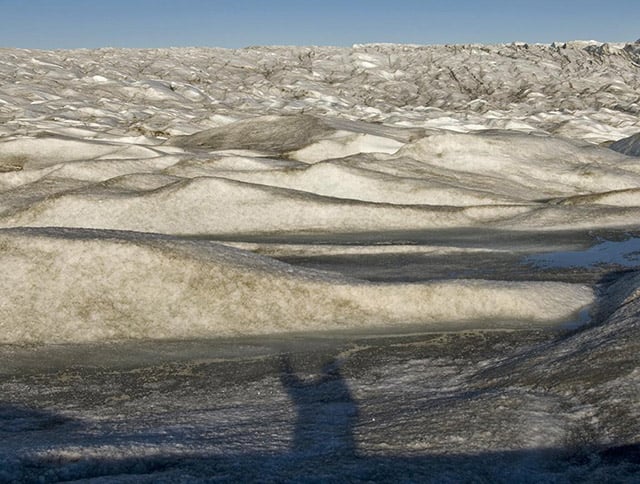 The author waves from a point about a mile onto the ice sheet near what is called Point 660, about 25 miles from Kangerlussuaq, on the west coast of Greenland, 100 miles north of the Arctic Circle. Dust accumulates on the ice from as far away as Siberia. As the ice melts, most of the dust is left behind to absorb more sunlight and melt more ice in a climate change feedback that has already begun. (Photo: Bruce Melton)
The author waves from a point about a mile onto the ice sheet near what is called Point 660, about 25 miles from Kangerlussuaq, on the west coast of Greenland, 100 miles north of the Arctic Circle. Dust accumulates on the ice from as far away as Siberia. As the ice melts, most of the dust is left behind to absorb more sunlight and melt more ice in a climate change feedback that has already begun. (Photo: Bruce Melton)
Greenland is warmer than it has been in more than 100,000 years and climate disrupting feedback loops have begun. Since 2000, ice loss has increased over 600 percent, and liquid water now exists inside the ice sheet year-round, no longer refreezing during winter.
Melt and ice loss dynamics from Greenland are far more complicated than we understood just a few years ago. New discoveries have been made that add large uncertainties as to exactly how fast ice melt and iceberg discharge will increase in the future. Over the last decade, continued research into the rate of ice loss in Greenland has downplayed any rapid acceleration of current melt rates. New discoveries could be changing our understanding of this last decade’s work.
To see more stories like this, visit “Planet or Profit?”
Greenland: Warmer Than in 100,000 Years
About 5,000 years ago, Greenland reached its warmest period in over 100,000 years. Since this time, Greenland had been cooling and the ice sheet was stable or growing. Beginning 30 to 40 years ago, however, a rapid reversal of cooling and ice sheet growth began.
The last 18 years have seen more melt than average across the ice sheet every year with an increasing trend that peaked in 2012 when the entire ice sheet surface temperature went above freezing for four days. (1) The melt line, or the elevation on the 11,000-foot-high ice sheet where the temperature does not rise above freezing in any given year, has steadily been increasing since the 1970s. (2) All of this melt is exposing areas beneath the ice sheet that have not been exposed in a very long time.
Across Baffin Bay to the west of Greenland is Baffin Island. This is the largest of the islands in the Canadian Arctic Archipelago, and ranked the fifth largest in the world; it is almost as big as Texas (Greenland is the largest). Baffin Island has its own ice cap as well as satellite ice caps to the main body of ice. It is these satellite ice caps that attracted the attention of researchers.
Collecting samples, Baffin Island, Professor Gifford H. Miller, University of Colorado, Institute of Arctic and Alpine Research (INSTAAR)
Led by the Institute of Arctic and Alpine Research, University of Colorado, Boulder, these researchers found dead plants and mosses still rooted in the ground immediately adjacent to the melting ice. The plants were dated with carbon-14 dating techniques to a time period 44,000 years ago that was in the depths of the last 100,000-year-long ice age. (3) At that time, the ice was growing and temperatures in the Arctic were 25 to 35 degrees Fahrenheit colder than the warmest time of our current interglacial era – the time between ice ages. The average temperature across the globe was 9 to 14 degrees colder than today. (4)
To find temperatures similar to today’s, we would have to go back nearly 120,000 years ago to the previous warmup between glacial periods, so it is virtually certain from these findings that the plants that these researchers found have not seen daylight in over 100,000 years. One of the amazing things this work reports is that some of the mosses at the 145 sites surveyed began to regrow once the ice melted away. (5)
Since the global thermal maximum temperature that occurred after the end of the last ice age about 5,000 years ago, Baffin Island cooled nearly 5 degrees Fahrenheit, but since the 1960s, this area has warmed nearly 7 degrees Fahrenheit, and the snow line has increased in altitude over 2,700 feet (half a mile). (6) This research definitively puts to rest the talking point that Greenland was warmer than today at any time in the past 100,000 years. The warming has also taken place entirely in the last 50 years, and during this entire 5,000-year-long period the natural cycles have been cooling, not warming.
The Dust Feedback
As the ice sheet melts around its edges, dust captured in eons of snow becomes exposed. Most of this dust does not get washed away by melt, partially because much of the ice loss is from sublimation, the process by which ice evaporates directly instead of changing into water. But much of the dust also stays in place on the ice simply because the flow speed of meltwater is very low except where it concentrates into what the scientists call supraglacial stream flow, or simply melt streams on the ice.
As more ice melts, more dust gets left behind on the ice. This has radical implications for increased melt because dust absorbs far more sunlight than ice. An example is that ice reflects up to 90 percent of sunlight back into space where dirt, rocks, plants and open water absorb up to 90 percent of sunlight and change it into heat.
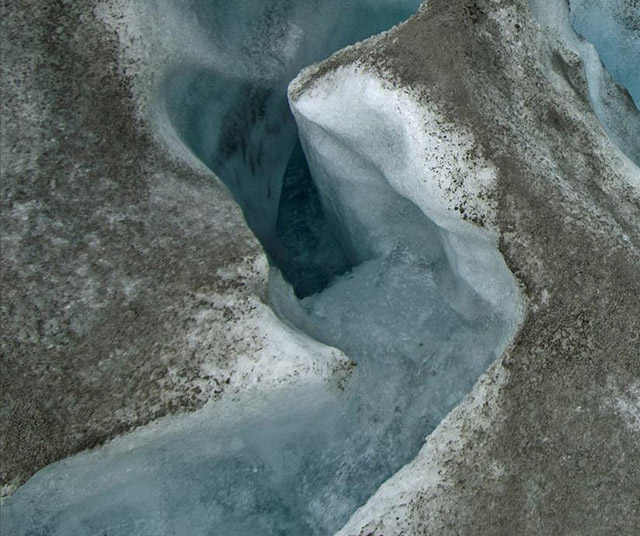 An ice sheet drain or moulin carries melt water into the depths of the ice sheet through crevasses. This image illustrates how little of the accumulated dust on the ice sheet washes away with melt runoff. (Photo: Bruce Melton)
An ice sheet drain or moulin carries melt water into the depths of the ice sheet through crevasses. This image illustrates how little of the accumulated dust on the ice sheet washes away with melt runoff. (Photo: Bruce Melton)
Since 2000, the amount of dust in the ice sheet has increased 5 percent, or more accurately, the brightness has decreased by 5 percent. (7) The National Snow and Ice Data Center, 2014 Melt Season Review says:
The darker snow absorbs more sunlight, leading to earlier melt onset and overall more melting, even if air temperature conditions are similar to previous years (as was the case in northwestern Greenland in 2014). Darker snow is a result of increased soot, dust, and even microbes in the snow, and the general trend of warmer summer conditions.
The melt season length has increased an astonishing 70 days in the last 35 years, significantly more in the fall than in the spring. Another study referenced by the National Snow and Ice Data Center says that new-fallen snow reflects 2 percent less sunlight than it did in 2003 (from 12 percent to 10 percent). This small amount of light energy is equal to 15 to 20 percent more heat. (8) The report goes on:
The amount of energy from the sun that the snow absorbs increases, leading to earlier melt, more pronounced snow and ice evaporation (sublimation), melt run-off, and later re-freezing of the ice sheet surface.
In 2009, an abrupt shift in sunlight absorption was reported by researchers at Météo-France and other French climate science institutions. Their research says this is “due to a persistent increase in the amount of soot or dust in new-fallen snow over the island.” (9)
Jason Box is one of the world’s leading ice sheet scientists. This short video talks about the contribution to decreased ice sheet sunlight reflection because of a darkening surface from dust and smoke and even microbial growth.
Ice Melt Lubricates Ice Sheet Flow
The melt zone extends 50 to 100 miles inland from the edge of the ice sheet. Something like half of the melt on the surface finds its way to the bed of the ice sheet through crevasses and moulins (big holes in the ice). (10) Some of the melt drains away rapidly once it hits bedrock, but some of it accumulates. It can even accumulate enough to float portions of the ice sheet six inches. (11)
When enough melt accumulates, friction is reduced and the ice sheet slips downhill. During this process, the lubricating water drains away. More melt accumulates and the process repeats. The whole process doesn’t end when melt ends in the fall, but extends through the winter period at a reduced rate – indicating that there is a large accumulation of water within and beneath the ice. The authors call this a “caterpillar-like” motion. We have known for nearly a decade now that meltwater lubricates the ice sheet, but this is the first time that multiple measurements of movement have been taken at different depths in the ice sheet and compared to accumulating meltwater.
So Much Ice Melt, Greenland Sunrise Seen Three Weeks Early in Spring
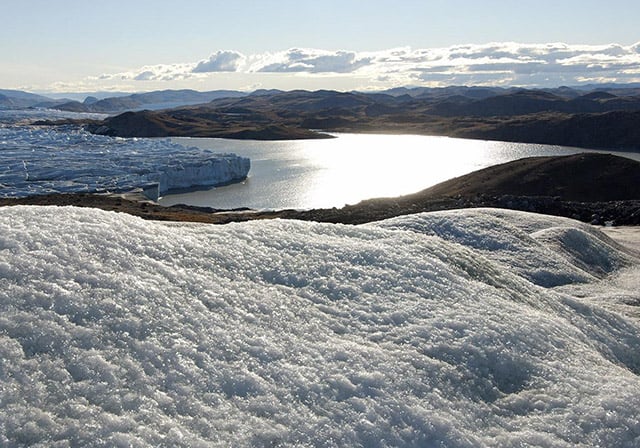 Ice margin lake on the Russell Glacier near the Arctic Circle on the west coast of Greenland. (Photo: Bruce Melton)
Ice margin lake on the Russell Glacier near the Arctic Circle on the west coast of Greenland. (Photo: Bruce Melton)
For its size, no other place on earth has been impacted by climate change more than Greenland. This Mexico-sized island is almost completely covered with ancient ice up to two miles thick. The ice has melted so much around the edge of Greenland that in a west coast settlement called Uummannaq, after a long dark winter, the sun rises above the melt-reduced, icy eastern horizon three weeks early. (12)
Contrary to Popular Reporting, the 2012 “Total Ice Sheet Melt Event” Was Not a Common Thing
In 2012, when the Summit Research Station – at the highest point of the Greenland ice sheet – experienced melt for the first time since 1889, it was widely publicized that this event happens about every 150 years. But, like so many things in the media about climate change, this was a widely distorted piece of reporting. The melt event prior to the 1889 event at the Summit Station happened about 1178.
Prior to the 1178 melt event at the Summit Station, as interpreted from ice cores, there were 16 melt events at the top of the Greenland ice sheet over a 5,000-year period. So the average is much more than twice the suggested 150-year period. But more importantly, the global thermal maximum occurred in this period. It was the warmest time in the last ice age cycle that happens about every 100,000 years. Before the global thermal maximum, the top of the ice sheet did not melt a single time dating back to about 120,000 years ago.
This is an easy piece of definitive science. The ice sheet has been cored numerous times all the way to the bottom. We can count the years of snow accumulation just like the rings in the trunk of a tree. Winter snow is dirtier than summer snow because it is drier and dustier, and summer snow is coarser, leaving behind those telltale bubbles that reveal so much else about our ancient climate.
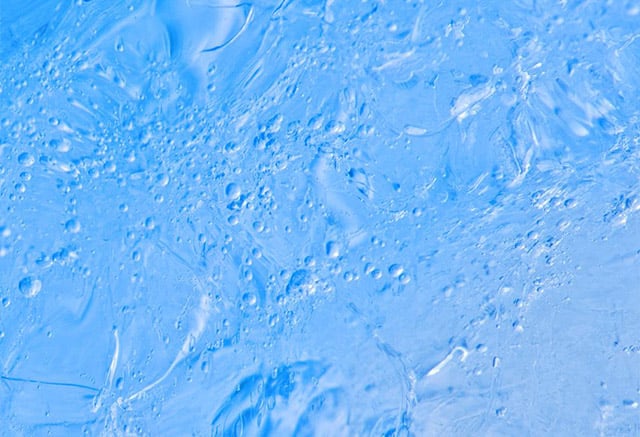 Bubbles in Greenland ice: This sample was taken from a bergy bit, which is the real scientific description for a small chunk of iceberg. It does not reveal the traditional banding of summer/winter snows, possibly because it has been reworked by folding processes on its way to the ocean. The layering is only visible in areas where ice flow is minimal such as the upper layers of ice or cores from the center of the ice sheet where ice flow has not distorted the layering. (Photo: Bruce Melton)
Bubbles in Greenland ice: This sample was taken from a bergy bit, which is the real scientific description for a small chunk of iceberg. It does not reveal the traditional banding of summer/winter snows, possibly because it has been reworked by folding processes on its way to the ocean. The layering is only visible in areas where ice flow is minimal such as the upper layers of ice or cores from the center of the ice sheet where ice flow has not distorted the layering. (Photo: Bruce Melton)
In 2012, researchers at the latest ice coring project called NEEM (North Greenland Eemian Ice Drilling Project) were able to experience one of these events firsthand. The melt creates a very distinct layer and this firsthand experience helped to confirm the other events found within the ice core. We only have one ice age cycle discovered in Greenland ice so far. There are many more tangled in the distorted layers of ice at the bottom of the ice sheet, but, as of yet, we have not found good, clean straight ice that is older than 120,000 years that can be accurately dated. Over the last decade, a lot of science has been published that shows Greenland will melt slowly like an ice cube, easing fears of runaway sea level rise from Greenland at least. Increasingly, research is also showing that sea level rise in past warm periods has been dominated by Antarctica. But there is more new science from Greenland that is leaving climate scientists concerned, and some serious head-scratching is going on.
Tunnels Under the Ice
Increased resolution of new technologies that can penetrate ice and “see” what’s beneath it have revealed some alarming findings. We have known for decades that the weight of the 11,000-foot-thick ice sheet has depressed the center of Greenland below sea level. Now, we find massive gorges beneath the ice where rapidly warming seawater has the chance to circulate deep beneath the ice sheet.
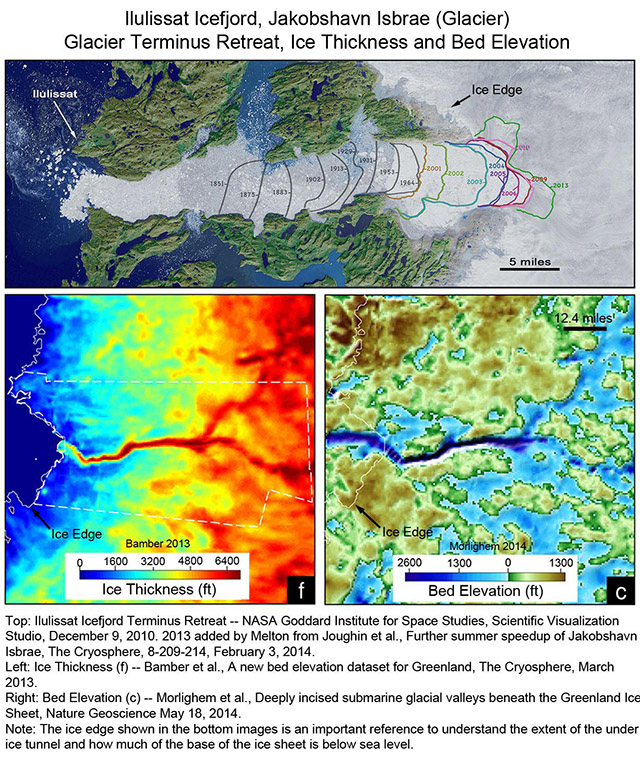
The Jakobshavn Glacier, or Sermeq Kujalleq (in Greenlandic), was one of the fastest and most prolific ice sheet discharge points in Greenland. In 2012, the Jakobshavn became the fastest glacier in the world by moving 10 miles in a single year. (13)
Long a major study area for iceberg production, and claimed by some to be the most likely origin of the iceberg that sank the Titanic, the Jakobshavn Glacier is home to the Unesco World Heritage Site: Ilulissat Icefjord.
According to the Intergovernmental Panel on Climate Change, Greenland ice loss has increased a phenomenal 632 percent since 2001. (14) This increase is coming from melt, sublimation (ice evaporating directly without melting first), melt penetrating to the bottom of the ice sheet through crevasses and moulins, and from rapidly warming Arctic Ocean waters penetrating beneath floating outlet glaciers, destabilizing these glaciers and increasing their flow.
The research that crowned the world glacier speed king/queen comes from the Polar Science Center at the University of Washington. Also revealed in this work are “large seasonal speedups” – 30 to 50 percent greater speeds than previous summers. The Jakobshavn’s speed is nearly three times what it was in the mid-1990s.
This 10 miles per year record is equal to about 150 feet per day. Across the five-mile width of the 3,000-foot-thick glacier, this is over 10 billion cubic feet of ice per day, or nearly 50 million tons of ice – per day!
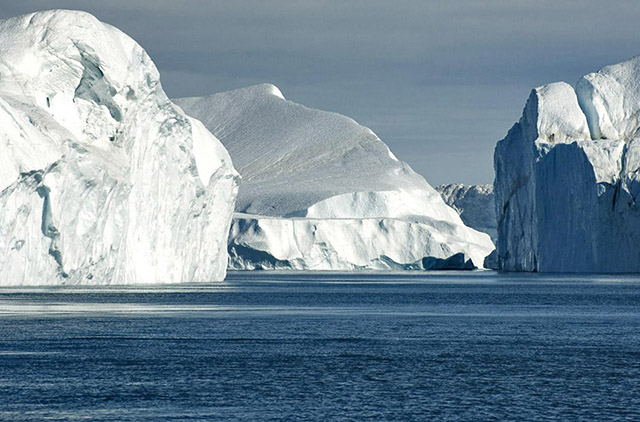 Small town-sized icebergs jam the mouth of the Ilulissat Icefjord in western Greenland. (Photo: Bruce Melton)
Small town-sized icebergs jam the mouth of the Ilulissat Icefjord in western Greenland. (Photo: Bruce Melton)
This speed record has coincided with the Jakobshavn calving front retreating to the edge of the ice sheet where a rise in the bed or a “sill” half fills the fjord.
Previously, the intact glacier front was grounded on this rise, but now the glacier front has retreated inland, into the ice sheet. Icebergs can now calve and float smoothly over this “sill.”
But there is more to this part of the story. As seen in the above image, the icefjord extends far inland beneath the ice. Warm ocean waters can now penetrate beyond the sill. The coldness of the ice actually drives a current, as cold water is denser than warmer water. This dense water drains out of the icefjord due to gravity and warm water replaces it. Of particular concern, farther north beneath the ice, there is a larger area where Greenland is depressed below sea level. Similar areas under icefjords extend into the interior of Greenland from the northwest and northeast. At this time, there is no published conjecture on how these new discoveries could change ice discharge from Greenland, but research on the Jackobshavn says:
Because the glacier has reached this critical area of its flow path, an increase in average annual speed of up to 10 times its 20th century speed could occur in the next few decades.
The authors also go on to say that once this coming acceleration phase passes, and they do not suggest how long it will last, that it is likely that discharge will slow once again. And as a reference, for what a 10 times increase in speed would mean for the Jakobshavn, the report says that total 2001 to 2010 discharge equaled about 1 millimeter of sea level rise. And for further reference, the Jakobshavn drains about 7 percent of the Greenland ice sheet.
A 27,000-Square-Mile Surprise in the Southern Greenland Ice Sheet
And what a surprise it is. Since the 1970s, the southern Greenland ice sheet has been home to an aquifer. Yes, an aquifer – inside of the ice sheet. The aquifer is liquid, and it remains liquid through the winter and persists in a liquid state from year to year. (15)
It is formed from summer melt and has been found up to an ice elevation of about 2,600 feet. The upper parts of the ice sheet, where snow compacts to ice, is called the firn zone. The water is contained in the firn zone in a very similar way that water is found in a sand or gravel aquifer anywhere else on earth.
It does not appear that the amount of water has significantly increased since its discovery in 2011, but very few measurements have been made. The top of the water layer lies between 16 and 160 feet from the surface and no accurate measurement of the bottom of the aquifer has been made, although it does not extend below the solid ice area of the ice sheet, which begins at the bottom of the firn layer, several hundred feet below the top of the ice. The total weight of water in the aquifer is estimated at 322 to 1,289 gigatons. For scale, the Jakobshavn Glacier discharges 16 gigatons of water per year.
How in the world does this water stay liquid all winter long – inside of the Greenland ice sheet? Snow is an excellent insulator to start with, then the melt water carries its own heat deep into the ice, and as water refreezes around the edges of the aquifer, the freezing process actually releases heat that adds to the heat stored in the water (this is why they spray water on oranges in Florida on freezing winter nights). All of this physics allows the liquid water to counter intuitively persist through Greenland winters.
What Does All of This Mean?
This is a question that ice scientists ask themselves every day, and I am sure some of them have some pretty good answers. For me, what it means is that Greenland is warmer than it has been in over 100,000 years. Since the global thermal maximum about 5,000 years ago, Greenland has cooled 5 degrees Fahrenheit, but in the last 50 years, it has warmed back up that amount and added a couple of degrees of warmth for good measure. Every year that passes sees Greenland ice getting darker and darker, as more and more dust accumulates on the surface, and more and more energy is captured, melting more and more ice.
Snow itself has darkened enough so that the energy it absorbs is increased by 20 to 25 percent. The glaciers that discharge ice from Greenland have increased discharge by an incredible 600 percent and newly discovered tunnels beneath the ice may have the capacity to channel warm ocean water to where it can do the most damage destabilizing the interior of the ice sheet.
And the oddest of all, what will happen to this perennial water aquifer in the firn zone of the southern ice sheet when melt really gets to cooking up there?
Footnotes
1. Fifteen of the last sixteen years… National Snow and Ice Data Center, 2014 Melt Season in Review, January 22, 2015, National Snow and Ice Data Center/Thomas Mote, University of Georgia, Figure 2, Melt Area Anomaly, June, July, August, 2014. https://nsidc.org/greenland-today/
2. Equilibrium line changes of the Greenland Ice Sheet, 1970s to present… Howat et al., Expansion of meltwater lakes on the Greenland ice sheet, Cryosphere, February 1, 2013. https://www.the-cryosphere.net/7/201/2013/tc-7-201-2013.pdf
3. Greenland Warmed 7 degrees F since 5,000 years ago with a 9 percent decrease of summer insolation due to changing orbital cycles… Miller et al., Unprecedented recent summer warmth in Arctic Canada, Geophysical Research Letters, October 2013. From the conclusions: “This is the first direct evidence that contemporary warmth in the Eastern Canadian Arctic now exceeds peak warmth of the early Holocene, when summer insolation across the region was ~9% greater than present.” paragraph 16: “There also has been no trend in local snowfall amount since 1960 AD 223 [Koerner, 2005] despite recent warming; hence, the snowline rise of >830 m since 1960 224 AD most likely corresponds to a summer temperature increase of >3.7 °C. The magnitude of the reconstructed summer temperature decrease during the late Holocene is similar to estimates of Late Holocene cooling derived from borehole temperature profiles through the adjacent Greenland Ice Sheet (2.5 ± 0.5 °C [Dahl- Jensen et al., 2008]).” https://onlinelibrary.wiley.com/doi/10.1002/2013GL057188/abstract
4. Across the Arctic, 25 to 35 degrees Fahrenheit colder during the ice age, 9 to 14 degrees F globally … Alley, Wally Was Right – Predictive ability of the North Atlantic Conveyor Belt Hypothesis for Abrupt Climate Change, Annual Review of Earth and Planetary Science, February 2007, Figure 1 shows the temperature range for the last 100,000 years. https://shadow.eas.gatech.edu/~kcobb/abrupt/alley07.pdf
5. Mosses regrew after being melted out of the ice… Miller et al., Unprecedented recent summer warmth in Arctic Canada, Geophysical Research Letters, October 2013, paragraph 4: “Recolonization may begin within a few years of exposure, and the few moss clumps that escape rapid [wind] erosion commonly regrow.” https://onlinelibrary.wiley.com/doi/10.1002/2013GL057188/abstract
See also the video of Dr. Miller above, https://youtu.be/B2hbesz-Npk.
6. Snow-line Increased 2,700 feet… ibid., paragraph 12, page 6, pre-print version: “Fitting of a least squares linear regression to all of the data indicates an average snowline lowering of ± 20 m ka-1 (r2=0.45) at the 95% confidence level [from the global thermal maximum to 1960].” Paragraph 14: “Information on the snowline of recent decades is derived from repeat NASA lidar altimetry for the Penny Ice Cap (Fig. 1), and demonstrates that snowline rose above the Penny Ice Cap (i.e., >1980 m asl) between 2000 and 2005 AD [Webb et al., 2009], a snowline increase of >830 m since the mid 20th Century (square, Fig. 2A). A similarly large rise in the ELA over West Greenland (660 m) occurred between 1997 and 2011 AD [McGrath et al., 2013].”
7. Sunlight reflection decreased by five percent… Greenland Ice Sheet Today, January 22, 2015, National Snow and Ice Data Center, Figure 5a. https://nsidc.org/greenland-today/2015/01/2014-melt-season-in-review/
8. Dirty new fallen snow absorbs 15 to 20 percent more heat… Greenland Ice Sheet Today, June 20, 2014, National Snow and Ice Data Center, Darkening Snow. https://nsidc.org/greenland-today/2014/06/a-warm-southern-welcome-to-spring/
9. Abrupt albedo shift in 2009… ibid.
10. Melt drains to the base of the ice sheet and lubricates its slide to the ocean… Ryser, et al., Caterpillar-like ice motion in the ablation zone of the Greenland ice sheet, Journal of Geophysical Research, October 2014. https://onlinelibrary.wiley.com/doi/10.1002/2013JF003067/abstract
11. Greenland melt Ice sheet float 6 inches… Jay Zwally interview: Program Two: Global Warming on Greenland & Risk of Gulf Stream Collapse. https://old.globalpublicmedia.com/transcripts/458
Also a personal conversation with Dr. Russell Huff while awaiting a helicopter ride to Swiss Camp at the Hotel Hvide Faulk, Ilulissat Greenland. Dr. Huff said that their work had been interpreted in the media to be two to three feet vertically but that in reality it was only 6 inches.
12. Uummannaq, Three Weeks early… this was reported to the author in August 2007 by his host at the Old Camp Hostel in Kangerlussuaq. Uummannaq is on a massive fjord about 20 miles from the ice sheet some 400 miles north of the Arctic Circle. The ice cap on the massive spine of mountains on the south side of the fjord is capped with a low elevation ice cap. At Point 660 at Kangerlussuq, visual observation of the point where the old Volkswagen Winter Proving Grounds road ascended on to the ice sheet shows about 100 vertical feet of melt from when the road was built in 2001 until the date of the observation in 2007. This amount of melt has been seen all along major areas of the west and southwest Greenland coast.
13. Ten miles in one year… Joughin et al., Brief Communication, Further summer speedup of Jakobshavn Isbræ, The Cryosphere, February 3, 2014, fourth paragraph, page 212. https://www.the-cryosphere.net/8/209/2014/tc-8-209-2014.pdf
14. Greenland ice loss increased 632 percent since 2001… Intergovernmental Panel on Climate Change, Science Basis, Summary for Policy Makers, 2013, B.3 Cryosphere, page 7, second bullet. The average rate of ice loss from the Greenland ice sheet has very likely substantially increased from 34 [–6 to 74] Gt yr–1 over the period 1992 to 2001 to 215 [157 to 274] Gt yr–1 over the period 2002 to 2011. https://www.ipcc.ch/pdf/assessment-report/ar5/wg1/WGIAR5_SPM_brochure_en.pdf
15. Liquid water persists through winter inside of Greenland ice sheet… Forster et al., Extensive liquid meltwater storage in firn within the Greenland ice sheet, Nature, June 21, 2013.
Abstract: https://www.nature.com/ngeo/journal/v7/n2/abs/ngeo2043.html
Prepress: https://ntrs.nasa.gov/archive/nasa/casi.ntrs.nasa.gov/20140011561.pdf
Defying Trump’s right-wing agenda from Day One
Inauguration Day is coming up soon, and at Truthout, we plan to defy Trump’s right-wing agenda from Day One.
Looking to the first year of Trump’s presidency, we know that the most vulnerable among us will be harmed. Militarized policing in U.S. cities and at the borders will intensify. The climate crisis will deteriorate further. The erosion of free speech has already begun, and we anticipate more attacks on journalism.
It will be a terrifying four years to produce social justice-driven journalism. But we’re not falling to despair, because we know there are reasons to believe in our collective power.
The stories we publish at Truthout are part of the antidote to creeping authoritarianism. And this year, we promise we will kick into an even higher gear to give you truthful news that cuts against the disinformation, vitriol, hate and violence. We promise to publish analyses that will serve the needs of the movements we all rely on to survive the next four years, and even build for the future. We promise to be responsive, to recognize you as members of our community with a vital stake and voice in this work.
Please show your support for Truthout with a tax-deductible donation (either once today or on a monthly basis).